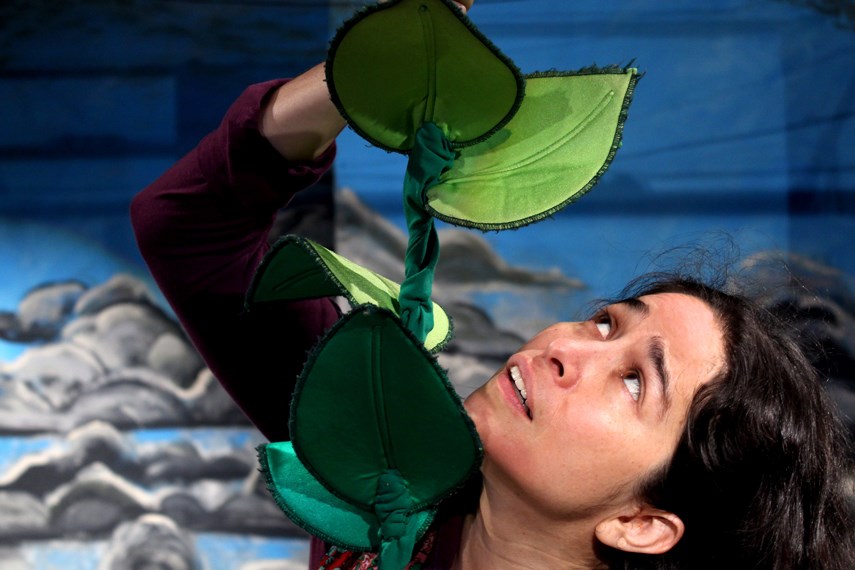Jack and the Magic Bean, co-produced by Presentation House Theatre and Mexico’s Marionetas de la Esquina at PHT, until April 28. For showtimes visit phtheatre.org.
Once upon a time, Linda A. Carson treated soil like dirt.
But in pursuing a degree at the University of Guelph, the playwright reluctantly enrolled in a soil science course. Taking the class, she recalls, was akin to a new scuba diver first fathoming the marine life teeming beneath the waves.
Carson saw the layers of life packed into a teaspoon of dirt and was inspired.
“We often go walking about our world and we forget about all the creatures and all the life going on right below our feet,” she says. “I thought: How cool to somehow get this onstage. For kids!”
Realizing soil alone might not sell tickets, Carson reached to a favourite fairy tale from her childhood and re-examined Jack and the Beanstalk. She would keep the giant and Jack, more or less. But Carson imagined Jacky’s farm as an arid swath of “dead dirt.” And, rather than gold, the giant’s riches would be his soil.
“That’s where Jack and the Bean clicked,” she says.
Carson wrote the play over two years, refining the action through workshops with Young People’s Theatre in Toronto, Ont.
“At one stage in the workshop I couldn’t figure out how the kids would hide from the giant,” Carson recalls.
The actors improvised a scene where the kids escape the fee-fi-fo-fumming gargantuan by pretending to be miniature bugs. The scene ended up underscoring the play’s themes of growing your own food and caring for the land.
While Jack the Giant Killer was published in 1711, the original tale of a boy scaling a mile-high beanstalk was published in 1734 as Jack Spriggins and the Enchanted Bean, written by the unlikely-named Dick Merryman.
The story, included in a one-shilling pamphlet extolling traditional Christmas virtues, featured a grandmother turning into a toad and that same grandmother’s cat transforming into a beautiful woman.
Jack plants the magic bean, however, “less out of hope for wealth and more from a love of beans and bacon,” according to author Mari Ness, who dissected the original tale for Tor.com.
“It’s a book that argues that the wealthy are not fulfilling their social responsibilities, that hints darkly that the wealthy can be easily overthrown, and replaced by those deemed socially inferior,” Ness writes.
Carson’s play explored similar territory in a Mexico City production staged by Presentation House Theatre and Marionetas de la Esquina – a Mexican theatre company specializing in puppetry. That run of shows centred on migrant workers ejected from the land.

“It’s off on its own legs,” Carson says of her play. “It’s almost like when you have kids and they go off into the world.”
The play’s success is somewhat remarkable given that Carson once found the idea of theatre for children “ridiculous.”
“Why do they need theatre?” she remembers thinking. “They’re just playing all day.”
But during her work with the Oily Cart theatre company out of London, England, Carson realized plays can help cultivate kids’ imaginations and allow them to play with each other in new ways.
The upcoming Presentation House Theatre production is directed by Carson’s husband, Kim Selody.
“It’s a dynamic relationship,” Carson says with a laugh. “When he doesn’t think an idea’s working he’ll just go: ‘That’s not working. Come up with some more ideas.’”
And while Selody emphasizes elements that will appeal to parents, the crux of Jack and the Magic Bean is for children.
“The kids are very much a part of the action,” Carson says.
The actors frequently improvise with the audience of three-to-eight year olds.
“One show is never the same as the show before,” she says.
The goal is to give children the sense that they’re right in the story, “helping it along,” Carson says.
While the journey may differ from Merryman’s original, Carson’s story still has the elements that arrested her attention as a child.
There’s the adventure of going up the beanstalk and the terrifying giant, she says. But there’s also: “the safety of knowing you were going to get back down.”
After nearly 300 years of golden eggs and bread-obsessed behemoths, there was likely never a Jack who was so happy to get down from the beanstalk and get back to the dirt.



